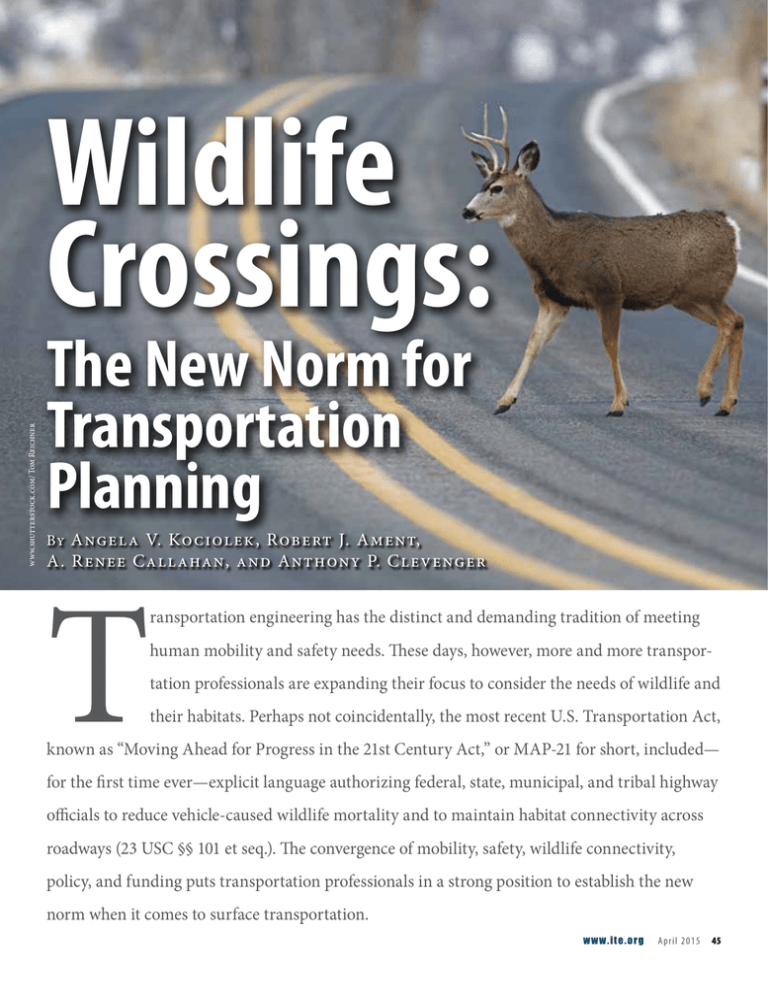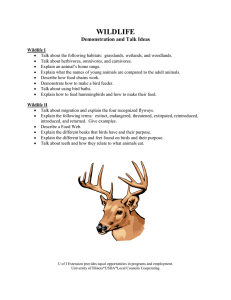The New Norm for Transportation Planning
advertisement

feature | www.shutterstock.com/ Tom Reichner Wildlife Crossings: The New Norm for Transportation Planning By Angela V. Kociolek, Robert J. Ament, A. Renee Callahan, and Anthony P. Clevenger T ransportation engineering has the distinct and demanding tradition of meeting human mobility and safety needs. These days, however, more and more transportation professionals are expanding their focus to consider the needs of wildlife and their habitats. Perhaps not coincidentally, the most recent U.S. Transportation Act, known as “Moving Ahead for Progress in the 21st Century Act,” or MAP-21 for short, included— for the first time ever—explicit language authorizing federal, state, municipal, and tribal highway officials to reduce vehicle-caused wildlife mortality and to maintain habitat connectivity across roadways (23 USC §§ 101 et seq.). The convergence of mobility, safety, wildlife connectivity, policy, and funding puts transportation professionals in a strong position to establish the new norm when it comes to surface transportation. w w w .i t e.or g Apri l 2015 45 This article explores the creative, economic, cultural, and operational dimensions of wildlife-highway mitigation and highlights several efforts by the Animal Road Crossings partnership to identify barriers, potential solutions, and collaborative opportunities. New Thinking on Proven Solutions Wildlife crossing structures in the form of overpasses and underpasses in combination with wildlife fencing (hereafter “wildlife crossings”) are proven to reduce wildlife-vehicle collisions by an average of 87 percent for animals deer-sized or larger, while allowing for their safe movement across roads.1 Installing such mitigation on road sections with as few as 3.2 deer-vehicle collisions/kilometer/year (7 deer-vehicle collisions/mile/year) would likely generate economic benefits to society.2 Cost-benefit analyses suggest there are many road sections in the U.S. and Canada where the benefits of installing wildlife crossings with fencing would exceed the costs associated with collisions between motorists and animals such as deer, elk, and moose.2 That’s why in 2010, in part to counteract rising construction costs, Animal Road Crossings (ARC) hosted the International Wildlife Crossing Infrastructure Design Competition, which sparked new thinking that has the potential to transform the way wildlife crossings are deployed (http:// competition.arc-solutions.org/finalists.php). Exploring the Influence of Culture on Wildlife Crossing Implementation Given that it may make economic sense to deploy wildlife crossings as a standard practice for problematic road segments, compared to the “do nothing” alternative, why has implementation occurred inconsistently, with some states having constructed many tens of wildlife crossings, while others have zero?3 To answer this question, the Technology Transfer Initiative of the ARC partnership set out to better understand how agency culture might be influencing implementation. Policy Act experts, environmental permitting experts, and road construction experts—indicates not only a great interest in the topic of wildlife crossing infrastructure but also potential strength in numbers for cultivating its implementation as a standard practice. Moreover, most survey respondents reported holding managerial roles, and most responses indicated a preponderance of agreement that wildlife crossings are needed. When asked to identify a single reason “there were obstacles or barriers to nationwide systemic deployment of terrestrial wildlife crossing structures,” the majority of respondents selected “economy and available funding” (67 percent; n=480) (Figure 1). Fortunately, as discussed above, when it comes to wildlife stewardship in the transportation context, investing in infrastructure can often make more economic sense than not. Although state DOTs nominally bear the expense of constructing wildlife crossings—which can be substantial—they act as stewards of public monies that can be justly used to build crossings where doing so benefits society through reduced collisions and improved connectivity. Figure 1. Relative Perception of the Main Obstacle or Barrier to Nationwide Systemic Deployment of Terrestrial Wildlife Crossing Structures Economy and available funding 325 No perceived priority by the motoring public 50 DOT-level policy and/or culture No percieved problem by the motoring public 36 25 Other 16 Personal belief that it is not possible to balance human mobility with habitat connectivity for wildlife 14 Federal policy 11 Technology and know-how 1 Not applicable; there are no obstacles or barriers 2 0 50 100 150 200DOT250 300 Source: Kociolek, A. Implementing Wildlife Crossing Infrastructure: Understanding Culture Interview/Survey Report Montana, USA, 2014. Available: http://arc-solutions.org/wp-content/ uploads/2014/03/FINAL-ARC-DOT-Survey-Results-and-Tool-Jan-2014.pdf. 350 Survey Says: Most States Consider Wildlife Crossings In a 2012 ARC survey of state department of transportation (DOT) professionals representing all 50 U.S. states, most respondents selected a “Yes” response to the following question: “Does your agency consider building wildlife crossings to improve safety and habitat connectivity for wildlife?” (84 percent; n = 589).4 While the specific circumstances may vary, these numbers clearly show that agencies that do not consider building wildlife crossings are in the minority (<16 percent). Similarly, almost four out of five respondents (79 percent) affirmed the agency trend toward ensuring that terrestrial wildlife can traverse the landscape and safely move across roadways (n = 589). The sheer number of respondents to this survey (n = 659; completion rate 68.4 percent)—representing road designers, road planners, bridge/structural engineers, road operations experts, road safety engineers, environmental scientists, National Environmental 46 Apri l 2015 i te j o urn al Forum Identifies Operational Barriers To deepen the dialogue about barriers to wildlife crossings as a standard practice, ARC held a forum at the 2013 International Conference on Ecology and Transportation. Titled “Culture and Crossings,” the event brought together 21 invited transportation-related professionals from state and federal agencies across the United States and Canada. Tens of barriers were identified as halting or slowing the deployment of wildlife crossings, but it was agreed that about half of them could be solved simply by changing the highway project planning process as currently practiced.5 The New Norm Notable wildlife mitigation efforts by local and state agencies are growing, and hopefully the same will hold true for federal land management agencies that are also in charge of roads within their jurisdictions.6-9 It is important that all state, federal, and tribal transportation and land management agencies consider wildlife crossings as a standard practice, because the systematic implementation of crossings is needed to assure habitat connectivity at larger scales, notwithstanding the recognition that more research is needed.10 The “Moving Ahead for Progress in the 21st Century Act” has begun to set the stage for promoting wildlife mitigation projects across our road network, and it is critical that adequate funding continue into the future. Established entities such as the American Association of State Highway and Transportation Officials and the Western Governors’ Association offer excellent examples of how a coordinated effort to align and streamline the implementation of a wildlife crossing infrastructure could work. Legislative support for wildlife-highway mitigation, in conjunction with strong federal and state leadership, builds on what many transportation engineers are already doing in their jurisdictions and provides a green light for the new norm of systematically deploying a network of wildlife crossings wherever they are needed across North America. itej References 1. Huijser, M.P., P.T. McGowen, J. Fuller, A. Hardy, and A. Kociolek. WildlifeVehicle Collision Reduction Study: Report to Congress. No. FHWA-HRT-08-034. Washington, DC, USA: Federal Highway Administration, 2007. 2. Huijser, M.P., J.W. Duffield, A.P. Clevenger, R.J. Ament, and P.T. McGowen. “Cost-Benefit Analyses of Mitigation Measures Aimed at Reducing Collisions with Large Ungulates in the United States and Canada: A Decision Support Tool.” Ecology & Society, Vol. 14, No. 2 (2009): article 15. Available: www.ecologyandsociety.org/vol14/iss2/art15/. 3. Bissonette, J.A. and P.C. Cramer. Evaluation of the Use and Effectiveness of Wildlife Crossings. National Cooperative Highway Research Program Report 615. Washington, DC, USA: Transportation Research Board, 2008. 4. Kociolek, A. Implementing Wildlife Crossing Infrastructure: Understanding DOT Culture Interview/Survey Report. Montana, USA (2014). Available: http://arc-solutions.org/wp-content/uploads/2014/03/FINAL-ARC-DOTSurvey-Results-and-Tool-Jan-2014.pdf. 5. “ARC Solutions—Western Transportation Institute Forum: 2013 International Conference on Ecology and Transportation (ICOET).” Notes from the Culture and Crossings Forum at the International Conference on Ecology and Transportation, Scottsdale, AZ, USA, 2013. Available: http:// arc-solutions.org/wp-content/uploads/2014/07/ARC-TTI-Forum-NotesList-of-Obstacles-ICOET-2013.pdf. 6. http://missoulian.com/news/state-and-regional/preliminary-workunderway-on-bakken-wildlife-crossing/article_de2b8e8c-820f-11e3948c-0019bb2963f4.html/. 7. http://trib.com/lifestyles/recreation/wyoming-wildlife-crossings-labeledsuccess/article_50658617-4dc9-5327-8bf3-4ce7c6f7778c.html/. 8. www.twincities.com/localnews/ci_25395311/washington-county-lookskeep-reptiles-off-road-people/. 9. http://www.dcourier.com/main. asp?ArticleID=91953&SectionID=1&SubSectionID=1. 10. Van der Ree, R., J.A.G. Jaeger, E.A. van der Grift, and A.P. Clevenger. “Effects of Roads and Traffic on Wildlife Populations and Landscape Function: Road Ecology Is Moving Towards Larger Scales.” Ecology & Society, Vol. 16, No. 1 (2011): article 48. Available: www.ecologyandsociety.org/vol16/iss1/art48/. Angela Kociolek, M.Sc., biological sciences, is a research scientist at the Western Transportation Institute-Montana State University, USA, where she conducts road ecology research and outreach to transportation professionals. Angela is currently the Technology Transfer Initiative Leader for animal road crossings, a partnership seeking to make wildlife crossing structures a standard practice across North America. Anthony (Tony) Clevenger, Ph.D., wildlife ecology, is a senior wildlife research scientist specializing in identifying factors influencing wildlife crossing performance and analyzing factors contributing to wildlife–vehicle collisions. He is a member of the U.S. National Academy of Sciences Committee on Effects of Highways on Natural Communities and Ecosystems. He has published more than 40 articles in peer-reviewed scientific journals and co-authored three books, including Road Ecology: Science and Solutions (Island Press, 2003). Rob Ament, M.Sc., biological sciences, is the road ecology program manager at the Western Transportation Institute (WTI)-Montana State University, USA. Rob has more than 30 years of experience in ecological studies, natural resource management, and environmental policy. At WTI, Rob leads efforts to research, monitor, and develop solutions to minimize the impacts of roads on the natural environment, wildlife, aquatics, vegetation, and climate change. Renee Callahan is the senior policy officer for the Center for Large Landscape Conservation in Bozeman, Montana, USA where she works to promote public policies that facilitate ecological connectivity and large landscape conservation. She has a master’s degree in environmental science and management from the University of California, Santa Barbara, and a Juris Doctor from the American University Washington College of Law. Previously, Renee was a partner with the law firm of Lawler, Metzger, Milkman & Keeney, LLC, in Washington, DC, USA and served as an attorney advisor within the Attorney General’s Honors Program at the U.S. Department of Justice. w w w .i t e.or g Apri l 2015 47




